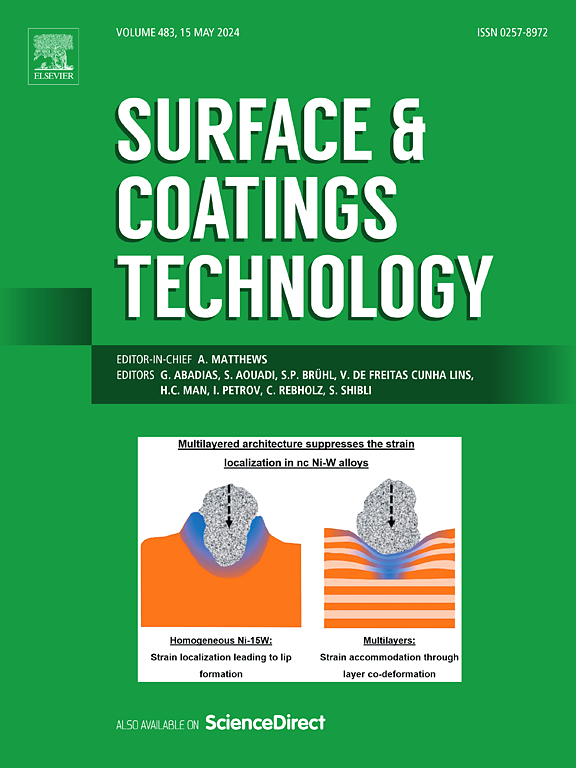Cold gas spraying of titanium on stainless steel to enhance corrosion protection inside proton exchange membrane water electrolyzers
IF 5.3
2区 材料科学
Q1 MATERIALS SCIENCE, COATINGS & FILMS
引用次数: 0
Abstract
In order to meet society's increasing energy needs and at the same time reduce the dependence on fossil fuels, it is essential to expand the production of renewable energies. However, a particular challenge of such energies is the discrepancy between energy production and demand. To bridge this gap, methods are needed to store the energy generated. One possibility is the production of green hydrogen by means of Proton Exchange Membrane Water Electrolysis (PEMWE), which can later be used to generate electricity. Consequently, it is crucial to develop cost-effective and resource-conserving manufacturing methods for electrolyzer stacks. In this study, we compare a conventionally used porous transport layer (PTL) on the anode side, which consists of a titanium felt, with a new type of PTL made out of a stainless steel expanded metal coated with titanium. Cold gas spraying (CGS) was selected as the coating process, which, like the production of expanded metals, is highly scalable. In addition, cold gas spraying has the advantage that the deposition can take place under normal atmospheric conditions, as comparatively low gas temperatures prevent titanium from undergoing any phase changes. This study shows that it is possible to coat 130 μm thin expanded metals without deformation or blockage. The microstructure was analyzed using scanning electron microscopy (SEM) and the phase composition was determined through X-ray diffraction (XRD) and energy-dispersive X-ray spectroscopy (EDS). The performance of different PTLs was compared by incorporating them into a proton exchange membrane (PEM) electrolyzer test cell. The newly fabricated PTL reached a current density of 2.6 A/cm2 at 2 V, which is only slightly lower than the benchmark value, reached with a full-body titanium felt, of 2.9 A/cm2. Compared to the full-body titanium felt, our new titanium-coated stainless steel-based PTL can reduce the amount of titanium needed by 68 %.
在质子交换膜水电解槽内对不锈钢进行冷态喷钛,提高其防腐性能
为了满足社会日益增长的能源需求,同时减少对化石燃料的依赖,必须扩大可再生能源的生产。然而,这种能源的一个特别挑战是能源生产和需求之间的差异。为了弥补这一差距,需要有方法来储存产生的能量。一种可能性是通过质子交换膜水电解(PEMWE)生产绿色氢,之后可以用来发电。因此,开发具有成本效益和资源节约的电解槽堆制造方法至关重要。在这项研究中,我们比较了阳极侧由钛毡组成的传统多孔传输层(PTL)与由不锈钢膨胀金属涂层钛制成的新型多孔传输层。选择冷喷涂(CGS)作为涂层工艺,与生产膨胀金属一样,具有高度的可扩展性。此外,冷气体喷涂的优点是可以在正常大气条件下进行沉积,因为相对较低的气体温度可以防止钛发生任何相变。该研究表明,可以在不变形或不堵塞的情况下涂层130 μm薄的膨胀金属。采用扫描电子显微镜(SEM)对其微观结构进行了分析,通过x射线衍射(XRD)和能量色散x射线能谱(EDS)测定了相组成。通过将不同质子交换膜(PEM)电解槽纳入质子交换膜(PEM)电解槽,比较了不同质子交换膜的性能。新制造的PTL在2v时达到2.6 a /cm2的电流密度,仅略低于用全身钛毡达到的基准值2.9 a /cm2。与全身钛毡相比,我们的新型钛涂层不锈钢PTL可以减少68%的钛用量。
本文章由计算机程序翻译,如有差异,请以英文原文为准。
求助全文
约1分钟内获得全文
求助全文
来源期刊

Surface & Coatings Technology
工程技术-材料科学:膜
CiteScore
10.00
自引率
11.10%
发文量
921
审稿时长
19 days
期刊介绍:
Surface and Coatings Technology is an international archival journal publishing scientific papers on significant developments in surface and interface engineering to modify and improve the surface properties of materials for protection in demanding contact conditions or aggressive environments, or for enhanced functional performance. Contributions range from original scientific articles concerned with fundamental and applied aspects of research or direct applications of metallic, inorganic, organic and composite coatings, to invited reviews of current technology in specific areas. Papers submitted to this journal are expected to be in line with the following aspects in processes, and properties/performance:
A. Processes: Physical and chemical vapour deposition techniques, thermal and plasma spraying, surface modification by directed energy techniques such as ion, electron and laser beams, thermo-chemical treatment, wet chemical and electrochemical processes such as plating, sol-gel coating, anodization, plasma electrolytic oxidation, etc., but excluding painting.
B. Properties/performance: friction performance, wear resistance (e.g., abrasion, erosion, fretting, etc), corrosion and oxidation resistance, thermal protection, diffusion resistance, hydrophilicity/hydrophobicity, and properties relevant to smart materials behaviour and enhanced multifunctional performance for environmental, energy and medical applications, but excluding device aspects.
 求助内容:
求助内容: 应助结果提醒方式:
应助结果提醒方式:


